As noted in Testing the first jets, the early jet engines were designed to last 25-35 hours (Germany’s) or 125 hours (England’s). Today’s jet engines rely on exotic materials and precision manufacturing so that they are almost 100% guaranteed to run 5000+ hours between major service events and the components will usually last at least 12,000 hours. Great for airlines and busy charter operators, but the typical private pilot with a family airplane flies only about 100 hours per year. Why does he/she/ze/they want to pay $500,000 to $1 million for an engine that is good for 50+ years of flying?
I wonder what would happen to the cost if we relaxed the reliability and service life specifications to be comparable to what we expect from a high-power piston engine, i.e., about 2,000 hours of operation and a failure every 50,000 hours. We can use parachutes for backup, like the Cirrus Vision Jet already does, or a second engine, if we’re making a “new Baron.”
Weekend pseudo-warriors of the sky who fly the L-39 are accustomed to overhauling the Ivchenko AI-25 engine every 1000 hours ($220,000, so about $220/hour, which would not completely change the economics of flying a Baron or a Cirrus). So that might be an example of what I’m talking about, but at a much higher level of power (blast a 10,000+ lb. aircraft to 400 knots).
I wonder if what we have now is an example of the best being the enemy of the good, leaving us with Wright Brothers-style piston engines in any aircraft that costs less than $1 million. Even a crummy turbine would have many advantages in terms of weight, smoothness, and, probably, reliability.
If the Germans could make a 35-hour jet engine at a reasonable cost in the early 1940s, with all of our modern technologies for machining, 3D printing, ceramics, etc., shouldn’t we be able to make a 2,000-hour turbine engine at a reasonable cost today?
From Oshkosh, 2003, a Sikorsky S-39, one of 21 built (1930s) and ripe for a turboprop conversion!
Related:
- Jetcat, which makes turbojet engines for radio-controlled aircraft. The company is in Germany and the expected hours of operation between overhauls is 25 hours, same as on the Me 262! (though the hobbyists say that the engines can easily run for 100 hours)
- Jet Central, a Mexican company that makes similar 25-hour turbines for the RC world.
- Someone who wouldn’t like the reduced reliability goal… “Pilot Sues Airline For Emotional Distress After Mechanical Failure Led To PTSD” (Plane & Pilot): A former QantasLink pilot is suing the regional carrier to the tune of $780,000 for suffering and damages from a case of PTSD she says was caused by a 2018 mechanical failure of one of the Boeing 717’s engines, which resulted in the shutdown of the engine and an emergency landing. … The plane landed without incident, and no one was injured. … She’s the first woman of color to wear a Qantas uniform, and she has received numerous awards for her work in aviation. She said recently, acknowledging the recognition she had earned for her historic place in Australian airline history, that her advice for younger Australians was, “People still stop me to congratulate me at how proud they are to see female pilot, let alone one of colour. My response is the same ‘Action Inspires Action’—you can achieve your dreams, too. Be the best possible human you can be.”

The Comp Air Jet seems to be in the ball park of what you’re asking for:
10900lbs gross weight, 350kn cruise, powered by that very same Ivchenko AI-25 engine. Seven passengers!
https://en.wikipedia.org/wiki/Comp_Air_Jet
That is just vapor ware!
The engine exists and is being used on manned aircraft. The drone version is $65K, apparently. https://minijets.org/en/100-150/pbs-tj100 No idea what it would take to get one or two of these in a four-seater.
I’m in, post the order form.
You can order a fancy new sailplane with a retractable jet engine. Some of them only have enough power to get home if the lift dies, not enough to launch. Plus there are the Sonex homebuilt jets. A turbine that could bolt on the front of legacy airframes with timed out piston engines would be a hit. Probably not coming to the certified world anytime soon.
https://rareaircraft.com/sales/aircraft-for-sale/antique/waco-agc-8-n2312-sn-5063/
184K for the minivan of airplanes. Bi-plane wing design makes it safe and easy to fly. The interior is a utilitarian box with passenger bench seating.
I used to brief new airline pilots on reliability and the maintenance program. One talking point was that most pilots would fly 30 years and retire without shutting down or losing an engine in flight. This was in the 757/767 era, I’m sure it’s even better now.
The original Cirrus jet was to have a version of the Williams target drone/cruise missile turbofan, but the engine never got certified. (And the airplane price went from $850K to $2 million). I lost track of the Williams engines, but your short-life engine would need to start from something already developed.
I spoke too soon. The Cirrus VLJ you flew to Key West has a Williams FJ33 turbofan certified in 2016, and several bizjets have FJ44’s.